The word ‘spectacular’ is not amiss because, although Caravaggio aimed at total realism, he wanted drama too. It was the secret of his instant, direct appeal to the Church, to collectors, to fellow artists, to the public, then and since. He depicts dramatic moments, whether cheating at cards or the very second a miracle occurs, in such a way that the viewer feels he is present and can step into the picture. The Church, which bought more than half his output, recognised the huge popular appeal of his vivid presentation of the faith. But it sometimes found Caravaggio too real for comfort.
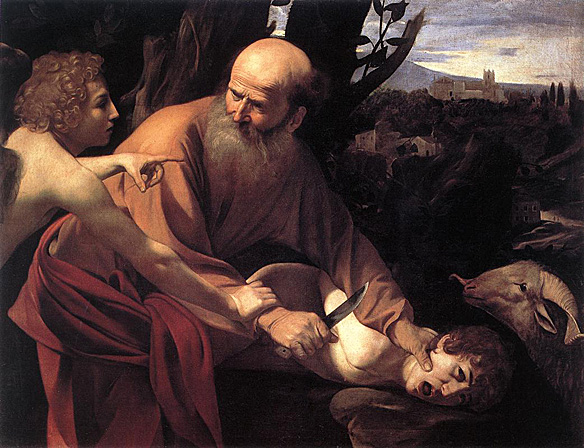
"The artist thrusts the action to the front of the picture frame like a sculpted frieze. Old Abraham, with features reminiscent of the saint in the second St. Matthew, is intercepted in the act of slitting his son's throat by an admonishing angel who with his right hand prevents the sacrifice and with his left points to the substitute victim. Light directs the viewer to scan the scene from left to right as it picks out the angel's shoulder and left hand, the quizzical face of Abraham, the right shoulder and terrified face of Isaac and finally the docile ram. A continuous movement links the back of the angel's neck to Isaac's profile. Caravaggio combines a hint of horror with pastoral beauty. In the foreground the sharp knife is silhouetted against the light on Isaac's arm. In the distance is one of Caravaggio's rare landscapes, a glimpse perhaps of the Alban Hills round Rome and an acknowledgement of the skill of his one serious rival, Annibale Carracci, whose landscapes were particularly admired."
“What in effect Caravaggio is doing systematically and deliberately, for the first time in the history of art, is destroying the space between the event in the painting and the people looking at it. He is giving us direct windows into life, whether religious life or ordinary life. Indeed, they are more than windows; we are in the same room or manger or tomb or prison where the events are taking place. Even we, whose vision and sense of reality has been blunted and distorted by television and the cinema, still get tremendous impressions of participating when we see his great canvases close to. What then must it have been like in the early seventeenth century, for people who had never come across anything approaching this blast of actuality, to be brought face-to-face with a reenactment of sacred events in two dimensions? Artists were particularly struck, or perhaps shocked is a better word; but horribly stimulated too, and stirred to find out exactly how the man did it.” ( Nicola Hodge, Libby Anson )
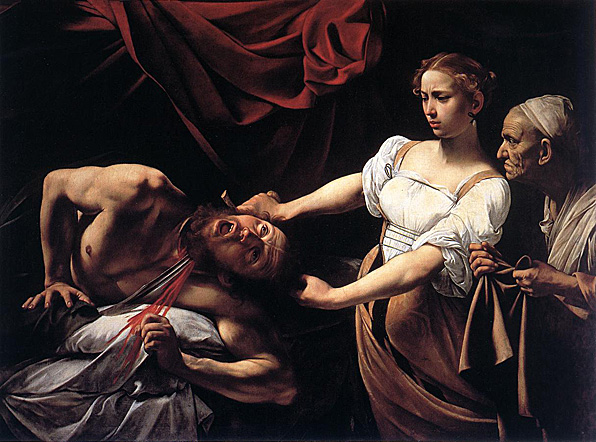
"A whole book in some versions of the Bible is devoted to Judith, because as a woman she embodies the power of the people of Israel to defeat the enemy, though superior in numbers, by means of cunning and courage. She seeks out Holofernes in his tent, makes him drunk, then beheads him. The sight of their commander's bloodstained head on the battlements of Bethulia puts the enemy to flight. In the painting, Judith comes in with her maid - surprisingly and menacingly - from the right, against the direction of reading the picture. The general is lying naked on a white sheet. Paradoxically, his bed is distinguished by a magnificent red curtain, whose color crowns the act of murder as well as the heroine's triumph. The first instance in which Caravaggio would chose such a highly dramatic subject, the Judith is an expression of an allegorical-moral contest in which Virtue overcomes Evil. In contrast to the elegant and distant beauty of the vexed Judith, the ferocity of the scene is concentrated in the inhuman scream and the body spasm of the giant Holofernes. Caravaggio has managed to render, with exceptional efficacy, the most dreaded moment in a man's life: the passage from life to death. The upturned eyes of Holofernes indicate that he is not alive any more, yet signs of life still persist in the screaming mouth, the contracting body and the hand that still grips at the bed. The original bare breasts of Judith, which suggest that she has just left the bed, were later covered by the semi-transparent blouse."
Caravaggio was born on September 28, 1571, in the small town of Caravaggio in Lombardy, between Milan and Brecia. His father, Fermo Merisi, was a builder and “clerk of works”, neither as high as an architect or as humble as a stonemason. North Italian painters, with their transalpine connections, had always had an element of realism, which Caravaggio naturally inherited. But he had no precursors. The only painter who may have set him on his chosen path was Giovanni Battista Moroni (c. 1525 1578), the brilliant portrait painter from Brescia, whose penetrating studies (Il Cavaliere dal Piede Ferito, The Tailor, The Lawyer) are among the treasures of London’s National Gallery. Essentially, however, Caravaggio created himself. He was antinomian, despising all laws of life and art. But his fatal propensity to break all the rules, which turned his life first into anarchy, then tragedy, also made him an artist of astonishing originality and creative power. He destroyed the old order and imposed a new one….
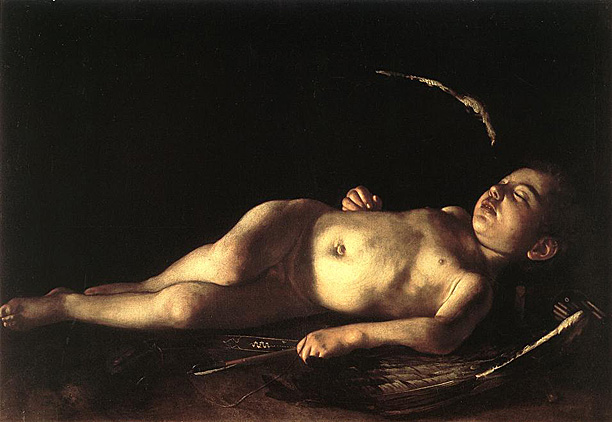
"Unlike many of Caravaggio's works, it can be dated accurately. It was commissioned for Fra Francesco dell'Antella, Florentiner Secretary for Italy to Alof de Wignacourt, Grand Master of the Knights of Malta, and an old inscription on the back records that it was painted in Malta in 1608. The subject of a sleeping Cupid, bowstring broken and arrows cast aside, usually signifies the abandonment of worldly pleasures, and dell'Antella may have commissioned it as a reminder of his vow of chastity."
Caravaggio’s career as a painter began in 1584 when he was a boy not quite thirteen years old and was packed off to Milan as an apprentice to a painter named Simone Peterzano. This unimportant artist claimed, lying probably, that he had studied under Titian himself. In any case, he painted in the Venetian manner, an influence on Caravaggio’s early work. Caravaggio would later insist that his own style was totally original, being based on Nature and no other prototype. But unless he walked around Milan with his eyes wide shut, which is improbable, there can be no doubt that Lombard painters like Antonio Campi, and Venetian ones like Jacopo Bassano and Lorenzo Lotto, impressed him; the suavely dramatic modeling and deep tones of the Venetian “cinquecento” were the basis of Caravaggio’s own contests between light and gloom.
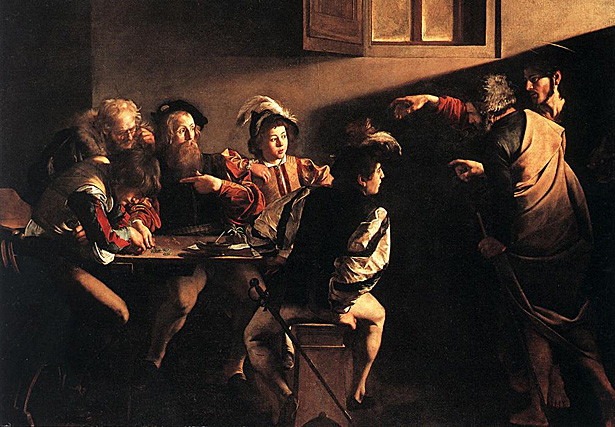
"The Calling of Saint Matthew is not Caravaggio's most well-known painting, and perhaps not even his best. But is is arguably his most revolutionary work. He painted it in 1600, a few years after he started with depicting religious scenes. Not only its superb use of light and shadow is remarkable, it caused quite a stir in early 17th century Italy, because Caravaggio showed through this painting that the mystery of God and His Calling can be set in common situations, such as a tax collectors office. This work can be visited in Rome, in the San Luigi dei Francesi church."
We do not know how long Caravaggio’s apprenticeship lasted, though it was meant to go on for four years. Whatever the case, he appeared in Rome in late 1592 or early 1593. At first he turned out hack work for a Sicilian artist known as “Lorenzo” then got taken under the wing of a minor papal bureaucrat, Pandolfo Pucci, whom the young painter is said to have nicknamed “Monsignor Insalata” because he served nothing for breakfast, lunch, and tea but salad. Caravaggio worked for a while in the studio of another hack painter, one Antiveduto Gramatica, and finally entered the studio of a timid creature named Guiseppe Cesari, who would later style himself as Cavaliere d’Arpino. The “Cavaliere” had Caravafggio paint details of fruit and flowers, and perhaps because of it the still-life artist matured within him earlier than the figure painter. Later Caravaggio made a celebrated remark to the effect that there was no hierarchical difference that he could see between painting figures and painting fruit: both were equally demanding , he said: each meant “tanta manifattura”
In the early seventeenth century, in a Rome still dominated by the long and absolute supremacy of figure composition, this position must have seemed eccentric. It was a strikingly modern opinion, one that could almost have dropped from Cézanne’s gruff table talk. Certainly, his earliest surviving pictures, such as the “Boy With the basket of Fruit”, painted about 1593, present the inanimate better than the animate. In the original, the boy’s flesh has a fuzzy and inert quality and the collarbone and throat are awkwardly modeled. However, the fruit: weight, texture and shape of each grape and peach are intimately described with a firm, spring sense of design. They look good enough to eat; a characteristic that Caravaggio would also give somewhat later, to his paintings of young boys.
this)" href="http://sexualityinart.wordpress.com/tag/caravaggio/">
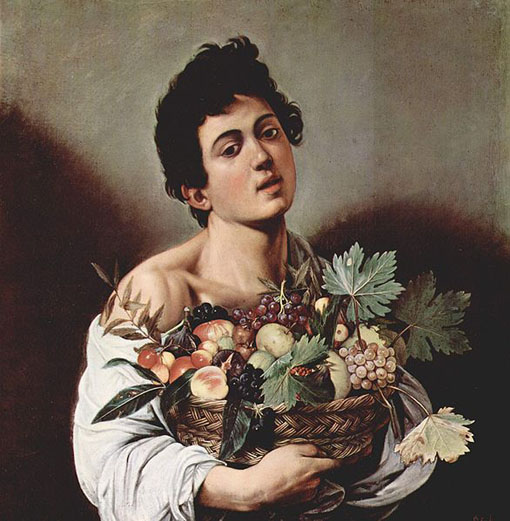
Caracvaggio. Boy With a Basket of Fruit








 COMMENTS
COMMENTS



